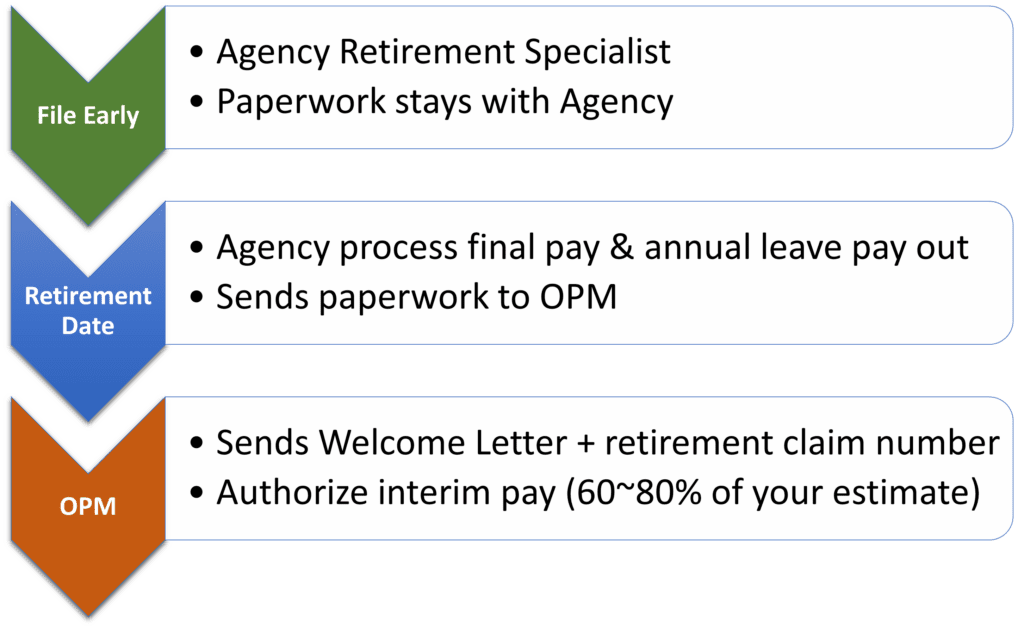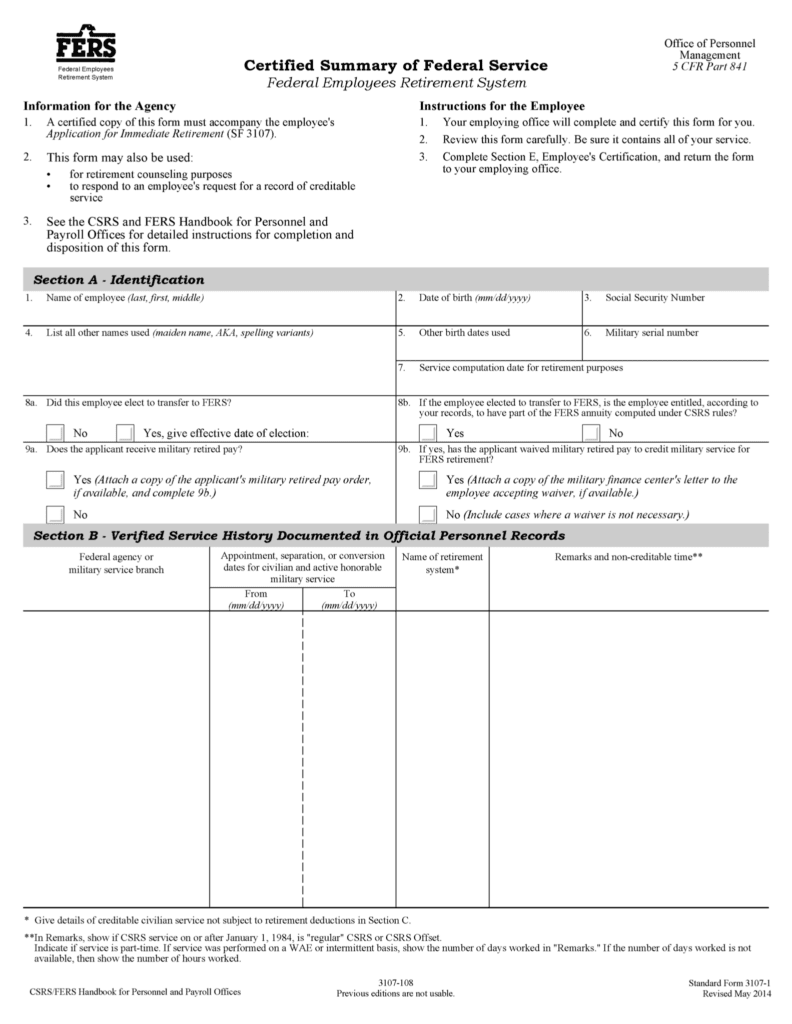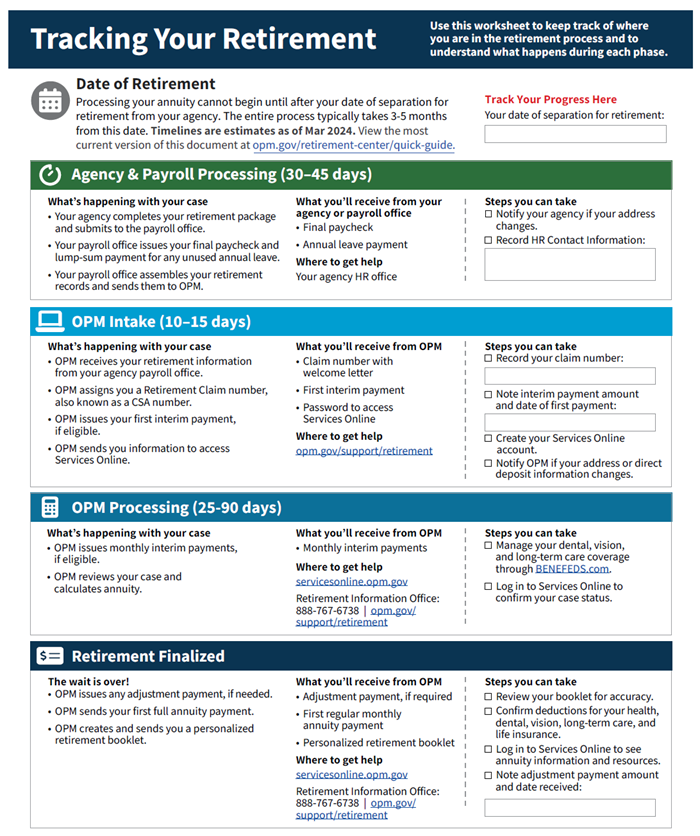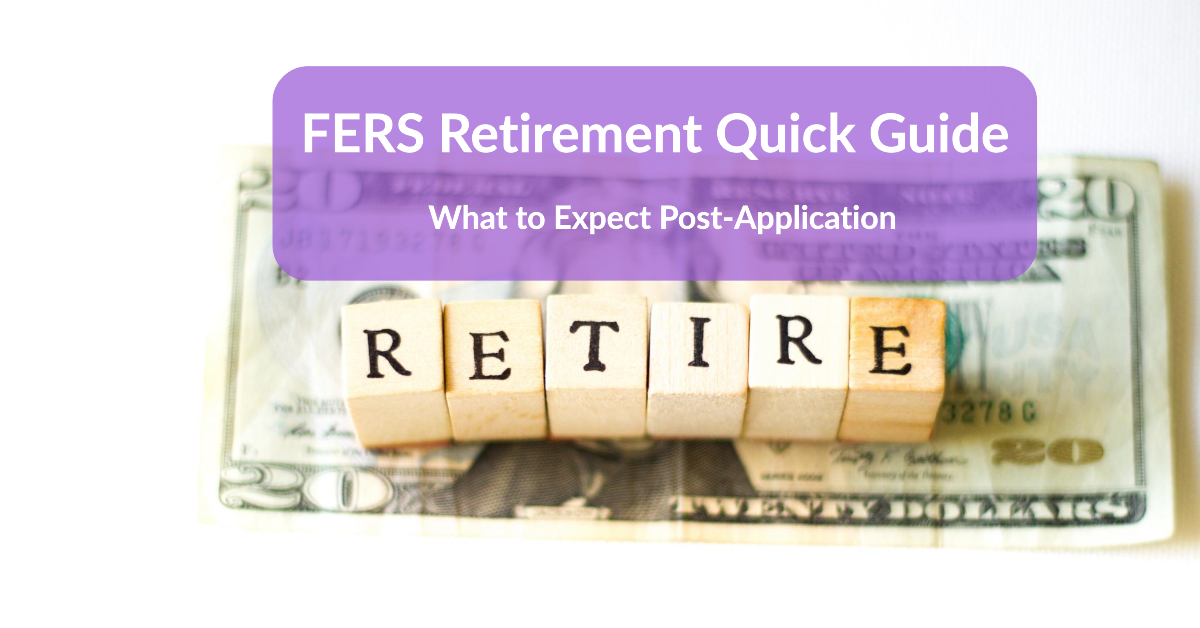FERS Retirement Quick Guide – What to Expect Post-Application
Retiring from federal service can be a complex process, but with the right knowledge and preparation, you can smoothly navigate through it. Let’s break down what to expect after you file your application for retirement. There are two forms that are required for FERS annuitants depending on whether you are filing for an immediate retirement or a deferred/postponed retirement. We’ve included the resources below.
Application for Immediate Retirement (SF-3107)

1. Pre-Retirement Preparation
Before retiring, it’s crucial to take several important steps to avoid delays in processing your retirement application:
- Confirm that your Retirement Service Computation Date (RSCD) is correct. Note on RSCD below.
- Sign all necessary forms to ensure a smooth transition
- Secure your personnel records from eOPF for future reference
- Settle any outstanding balances for service credit accounts
- Gather all required supplemental documents, such as marriage certificates, military records, and court orders
RSCD is NOT Leave Service Computation Date (LSCD)
The RSCD is used to calculate your federal years of service for the pension calculation. It is important to not confuse the RSCD with the LSCD date that is on your leave and earnings (LES) statement. Often, the LSCD and RSCD are the same, however it is better to assume they are not. Primary reasons for having a different RSCD and LSCD include:
- Breaks in service
- Military time
- Entered service with higher per-pay-period leave
At retirement, OPM will review all of your SF-50’s to confirm the RSCD after you file retirement paperwork. You can verify your creditable service time by submitting form SF-3107 – go to page 9 of the form titled, “Certified Summary of Creditable Service.” Submit to HR to verify the RSCD. We recommend confirming the RSCD sooner than later to avoid any surprises come retirement.

2. Understanding Your Benefits Choices
Federal retirees have various benefit choices to consider, including:
- Health benefit coverage selection
- FEGLI options (100%, 50%, 25%, none)
- Survivor Benefit election (50%, 25%, none)
- Beneficiary designations
3. Factors That May Delay Retirement Processing
Several factors could potentially delay the processing of your retirement application, including:
- Court orders such as divorce decrees
- Specialized service experiences such as Special Provisions Employee (LEO, Firefighter, ATC, etc.)
- Past or ongoing workers’ compensation claims
- Service across multiple federal agencies
- Incomplete or inaccurate documentation
- Failure to update your address with OPM
4. Retirement Process Timeline
Understanding the timeline of the retirement process can help you manage your expectations:
- Retirement processing typically begins after your official separation from your agency
- Your agency will prepare your retirement package within 30-45 days
- Upon OPM intake (10-15 days), you’ll receive a claim number and your first interim payment
- Interim payments are 60% to 80% of estimated final pension amount
- OPM will thoroughly review and calculate your benefits within 25-90 days
- Once your retirement is finalized, you’ll receive your first regular monthly payment and a personalized retirement booklet
5. Tracking Your Progress
It’s essential to monitor your retirement application’s progress:
- Utilize the OPM Quick Guide worksheet to track your progress.
- Create a Services Online account to receive updates and make changes to your information.

6. Interim Pay
During the processing period, you’ll receive interim payments to cover expenses:
- Interim payments typically constitute 60-80% of your estimated annuity
- These payments do not include deductions for health benefits or other expenses
7. Health and Life Insurance
Maintain your current health and life insurance coverage throughout the processing period:
- Your existing policies will remain active, with premiums deducted from your adjustment payment once processing is complete.
Sit Back and Enjoy a Wonderful Retirement!
By following these steps and staying informed throughout the process, you can ensure a smooth transition into federal retirement. Remember to consult the OPM Retirement Quick Guide and seek guidance from your agency’s retirement counselor for personalized assistance.
Reach Out to Us!
If you have additional federal benefit questions, reach out to our team of CERTIFIED FINANCIAL PLANNER™ (CFP®), Chartered Federal Employee Benefits Consultants (ChFEBC℠), and Accredited Investment Fiduciary (AIF®). At PlanWell, we focus on retirement planning for federal employees. Learn more about our process designed for the career federal employee.
Preparing for a federal retirement? Check out our scheduled federal retirement workshops. Sign up for our no-cost federal retirement webinars through this page. Make sure to plan ahead and reserve your seat for our FERS webinar, held every three weeks. Interested in having PlanWell host a federal retirement seminar for your agency? Reach out, and we can collaborate with HR to arrange an on-site FERS seminar.
Want to fast-track your retirement plan? Skip the FERS webinar and start a one-on-one conversation with a ChFEBC today. You can schedule a one-on-one meeting by visiting our contact page.











